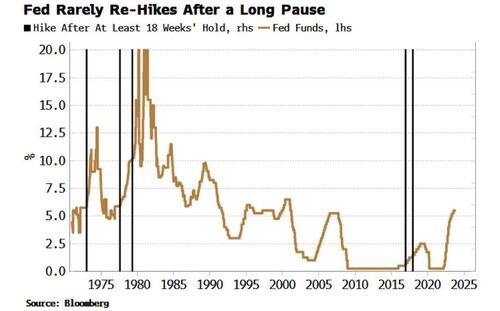
By Simon White, Bloomberg markets live reporter and strategist
The market is likely underpricing the probability of another rate hike by the Federal Reserve, despite the lack of precedents. Bond yields are starting to look on the low side and prone to being pulled higher by elevated nominal GDP.
The Fed last hiked its policy rate on the July 26, 18 weeks ago. It would be rare for the central bank to hike rates again after such a lengthy pause. There have been five occasions since 1971 when the Fed has done so (specifically, hiked rates after a pause of at least 18 weeks when the last move was a hike).
But when rates are already restrictive as they are today, it would be unprecedented. The longest the Fed has held rates after last hiking them, and then raising them again when rates are already restrictive - i.e. when the real Fed rate is greater than the neutral rate (using the Holston-Laubach-Williams estimate) – is 14 weeks, between August and November 1988.
This was another time when there was a long lead into the next recession, with several reliable signals flagging a contraction many months or years in advance. As the bottom panel of the chart below shows, the yield curve was inverted more than year before the recession began in July 1990. The Conference Board’s Leading Index was contracting at least eight months before the slump.
Nonetheless, the Fed resumed its hiking cycle, taking rates from 8.25% to a peak of 9.75% in 1989. They were then cutting them for over a year before the recession finally began. Ten-year yields continued to rise on net through 1988 and into the first quarter of 1989 as inflation began to re-accelerate.
Back to today, even though it would be unprecedented for the Fed to hike again after this long, that doesn’t mean it won’t happen, with stickier-than-expected inflation likely to require tighter policy. That leaves yields looking on the low side as they are pulled higher by greater short-term rates and stubbornly high nominal GDP.
By Simon White, Bloomberg markets live reporter and strategist
The market is likely underpricing the probability of another rate hike by the Federal Reserve, despite the lack of precedents. Bond yields are starting to look on the low side and prone to being pulled higher by elevated nominal GDP.
The Fed last hiked its policy rate on the July 26, 18 weeks ago. It would be rare for the central bank to hike rates again after such a lengthy pause. There have been five occasions since 1971 when the Fed has done so (specifically, hiked rates after a pause of at least 18 weeks when the last move was a hike).
But when rates are already restrictive as they are today, it would be unprecedented. The longest the Fed has held rates after last hiking them, and then raising them again when rates are already restrictive – i.e. when the real Fed rate is greater than the neutral rate (using the Holston-Laubach-Williams estimate) – is 14 weeks, between August and November 1988.
This was another time when there was a long lead into the next recession, with several reliable signals flagging a contraction many months or years in advance. As the bottom panel of the chart below shows, the yield curve was inverted more than year before the recession began in July 1990. The Conference Board’s Leading Index was contracting at least eight months before the slump.
Nonetheless, the Fed resumed its hiking cycle, taking rates from 8.25% to a peak of 9.75% in 1989. They were then cutting them for over a year before the recession finally began. Ten-year yields continued to rise on net through 1988 and into the first quarter of 1989 as inflation began to re-accelerate.
Back to today, even though it would be unprecedented for the Fed to hike again after this long, that doesn’t mean it won’t happen, with stickier-than-expected inflation likely to require tighter policy. That leaves yields looking on the low side as they are pulled higher by greater short-term rates and stubbornly high nominal GDP.
Loading…






